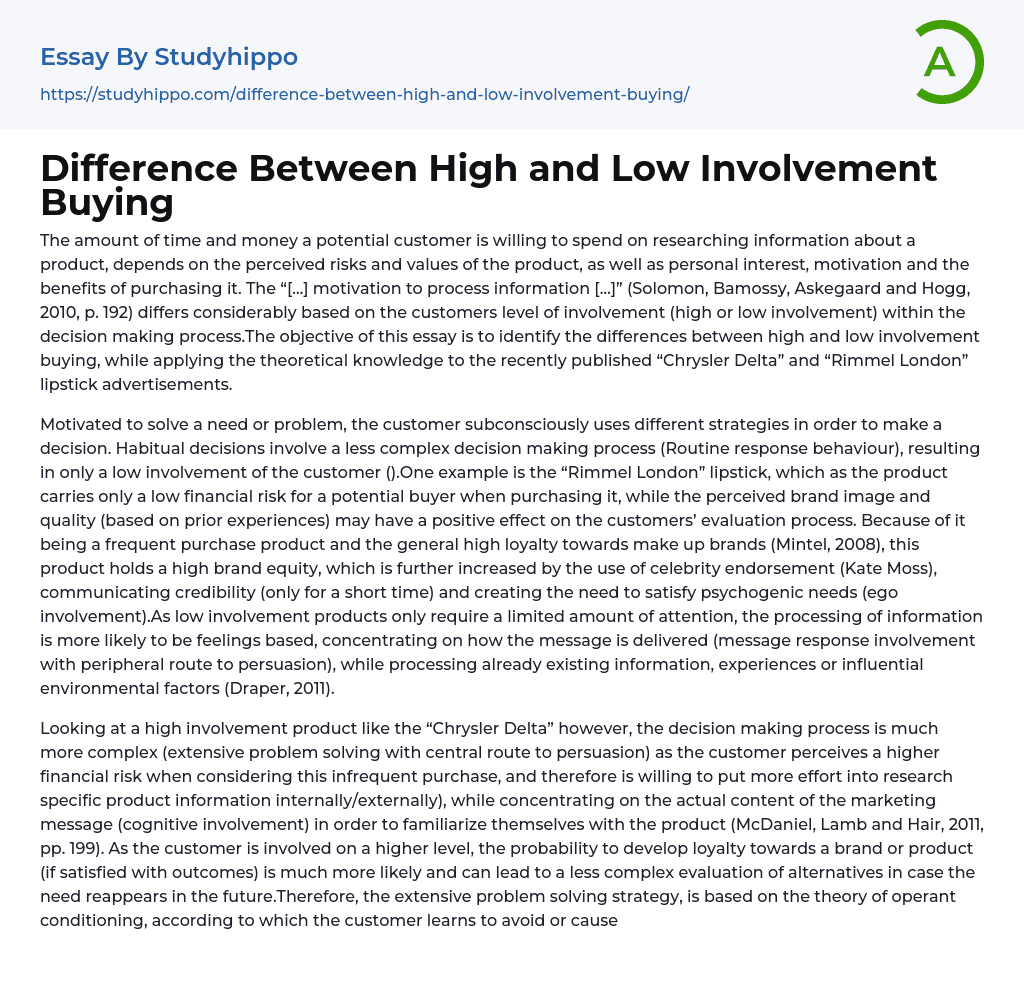

Difference Between High and Low Involvement Buying Essay Example
The amount of time and money a potential customer is willing to spend on researching information about a product, depends on the perceived risks and values of the product, as well as personal interest, motivation and the benefits of purchasing it. The “[…] motivation to process information […]” (Solomon, Bamossy, Askegaard and Hogg, 2010, p. 192) differs considerably based on the customers level of involvement (high or low involvement) within the decision making process.The objective of this essay is to identify the differences between high and low involvement buying, while applying the theoretical knowledge to the recently published “Chrysler Delta” and “Rimmel London” lipstick advertisements.
Motivated to solve a need or problem, the customer subconsciously uses different strategies in order to make a decision. Habitual decisions involve a less complex decision making process (Ro
...utine response behaviour), resulting in only a low involvement of the customer ().One example is the “Rimmel London” lipstick, which as the product carries only a low financial risk for a potential buyer when purchasing it, while the perceived brand image and quality (based on prior experiences) may have a positive effect on the customers’ evaluation process. Because of it being a frequent purchase product and the general high loyalty towards make up brands (Mintel, 2008), this product holds a high brand equity, which is further increased by the use of celebrity endorsement (Kate Moss), communicating credibility (only for a short time) and creating the need to satisfy psychogenic needs (ego involvement).As low involvement products only require a limited amount of attention, the processing of information is more likely to be feelings based, concentrating on how the message is delivered (message respons
involvement with peripheral route to persuasion), while processing already existing information, experiences or influential environmental factors (Draper, 2011).
Looking at a high involvement product like the “Chrysler Delta” however, the decision making process is much more complex (extensive problem solving with central route to persuasion) as the customer perceives a higher financial risk when considering this infrequent purchase, and therefore is willing to put more effort into research specific product information internally/externally), while concentrating on the actual content of the marketing message (cognitive involvement) in order to familiarize themselves with the product (McDaniel, Lamb and Hair, 2011, pp. 199). As the customer is involved on a higher level, the probability to develop loyalty towards a brand or product (if satisfied with outcomes) is much more likely and can lead to a less complex evaluation of alternatives in case the need reappears in the future.Therefore, the extensive problem solving strategy, is based on the theory of operant conditioning, according to which the customer learns to avoid or cause positive or negative outcomes through prior experiences or knowledge. The customer’s perception of low involvement products on the other hand, can be shaped through classical conditioning (the connection of two stimuli in order to create the same associations or reactions even when isolated), like the association of a celebrity (image) with a specific brand.In conclusion, high and low involvement purchase decisions differ, depending on the customer’s approach when making a decision (habitual, rational, behavioural), the perceived risks and benefits, as well as prior experiences with and the level of interest in a product.
Important factors when defining the scale of involvement are hereby, the amount of time and money
spend, the scope of research (internal/ external) and the number of evaluated alternatives.
- Bias essays
- Big Five Personality Traits essays
- Body Image essays
- Mind essays
- Motivation essays
- Phobias essays
- Thought essays
- Consciousness essays
- Intelligence essays
- Mindset essays
- Perception essays
- Problem Solving essays
- Resilience essays
- Board Of Directors essays
- Brand Management essays
- Business Ethics essays
- Business Management essays
- Change Management essays
- Comparative Analysis essays
- Decision Making essays
- Dispute Resolution essays
- Knowledge Management essays
- Leadership essays
- Leadership and Management essays
- Manager essays
- Operations Management essays
- Performance Management essays
- Product Management essays
- Project Management essays
- Quality Management essays
- Risk essays
- Risk Management essays
- Scientific Management essays
- Stress Management essays
- supply chain management essays
- Time Management essays
- Total Quality Management essays



